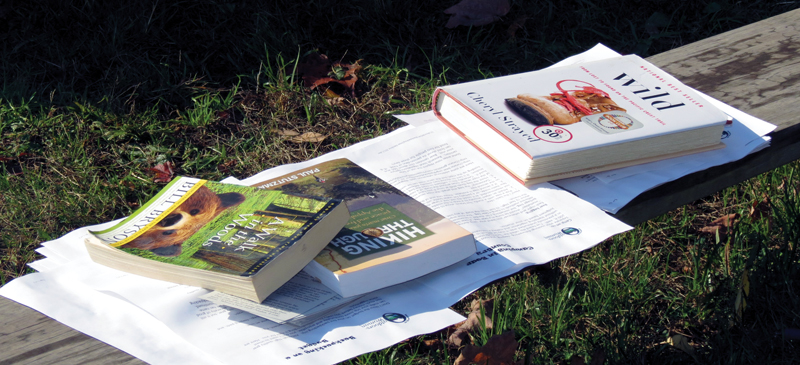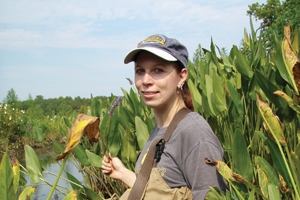From the Field: Kerry Wixted

Outdoors books; staff photo
A Baltimore City native, Kerry was always outside as a child. When she got on her first bicycle, she was off to Herring Run Park—exploring, investigating, listening—curious about the natural world within the city.
“Sundays with dad almost always involved a walk in Gunpowder Falls State Park or a trip to Loch Raven Reservoir,” she said. She also recalled kayaking with her family and watching with wonder as the carp spawned right in front of her nose, a sight and sound she will never forget: “That opened up a whole new world. You can see things from a kayak that you would never see when hiking.”

Kerry Wixted
Wixted graduated from Baltimore Polytechnic Institute in 2001, and earned a Bachelor of Science in Wildlife and Fisheries Management at Frostburg State University in 2005. She pursued graduate studies in Environmental and Evolutionary Biology and Biology at West Virginia University, earning a master’s degree in 2008.
Her graduate studies took her to eight states as part of a long-term study on wild populations of the medicinal plant, American ginseng—a species that has been harvested from forests in North America for more than 250 years. Her research examined the impact of invasive plants on this economically important herb.
She joined the Maryland Department of Natural Resources in 2009 as a contractual employee for the Natural Heritage Program. She conducted field research in Southern Maryland as well as inventoried and monitored rare species and their habitats. Although she misses field work, Wixted found her niche in education and outreach with the Wildlife and Heritage Service. Her passion is teaching and making a difference for wildlife.
“I want people to treasure what we have, especially in Maryland where there is so much diversity,” she said. She’s particularly interested in sparking curiosity about some “creepier” species such as bats, snakes and spiders.
Authors’ note: one of the best talks we’ve ever seen Kerry give was Making Spiders Sexy: How to Teach about Misunderstood Wildlife. It was standing room only, and she made the entire audience love—or at least appreciate—spiders.
Her duties are extremely diverse, without a “typical day” in her repertoire. She may start her week teaching about botany, mammals, or interpretation during a Master Naturalist training, and then—as the Project WILD state coordinator—travel to Western Maryland to teach educators how to use the curriculum with students. Then, she may visit a gardening group or homeowners’ association meeting to teach about local pollinators and backyard wildlife on the weekend.
A short time ago, Wixted received a grant from the Chesapeake Bay Trust to bring Growing Up WILD programs to early childhood educators. In less than a year, she worked with more than 200 such educators and designed a set of free kits, which were made available throughout the state.
Her work took her halfway around the world when she was selected to lead programming for educators with Japan WILD coordinator, Hiroshi Kawahara. Honored to receive such an amazing opportunity, she traveled to Tokyo earlier this year as a guest educator—a trip financed by the Parks and Recreation Foundation of Japan.
Stateside, Wixted is also a committee member and instructor with the Maryland Becoming an Outdoors-Woman program and develops educational materials for teachers, including the popular Wildlife Education Trunks. She also authors a seasonal newsletter for stewards of backyard wildlife, and coordinates education materials, training and testing for the wildlife section of the Maryland Envirothon.
Away from work, she likes to practice what she preaches. She and her husband, Dan, are creating wildlife habitat in their own yard.
“It’s been a 5-year battle so far,” she says, “but we have almost eradicated the periwinkle and other invasive plants.” In its place are mayapples and Virginia bluebells thriving underneath chestnut oaks in the front yard and a growing native pollinator garden in the back. An ode to their success, so far their visitors include gray and red fox, squirrels, the occasional opossum, birds and bees, spiders and snakes.
Article by Patricia Allen and Linda Wiley—Association of Fish and Wildlife director of communications and Office of Communications webmaster, respectively. Appears in Vol. 21, No. 2 of the Maryland Natural Resource magazine, spring 2018.


 1-888-373-7888
1-888-373-7888 233733
233733